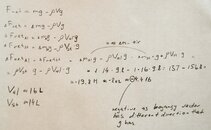The thing is it's not the only component in the equations so it does not really matter that it's not going to change

It is in fact not even involved in the final formula.
Here we go: As a base I took the initial formula from wikipedia which is right (I checked it myself)
Buoyancy - Wikipedia, the free encyclopedia
http://upload.wikimedia.org/math/a/9/e/a9e680082e41ce9d9675bf7dd680c5f2.png
Check it out and if you find anything wrong please let me know. I want to find the truth here

The steel tank taken is HP100 say filled to 77.4 cuf to make the mass of air the same.
Even with all that I am failing to see how the buoyancy swing will be different in an aluminum cylinder vs. steel. The metal the cylinder is made from isn't going to affect the buoyancy from full to empty, since the metal isn't changing throughout the dive.
The ONLY thing changing throughout the dive is how much gas is inside the cylinder, which effects the weight and average density (and thus the buoyancy) of the cylinder. The inherent buoyancy characteristics of the cylinder's metal isn't going to change.
I believe your calculations are canceled out by what I posted earlier with regards to cylinder sizes vs. buoyancy swing. Read that list carefully again -- I'll post it below, plus the physical sizes of the cylinders in question:
me:
Luxfer Al80 (3000psi, 77.4cf): -1.4lbs full, +4.4lbs empty = 5.8lbs swing
Faber HP80 (3500psi, 80cf): -13.22lbs full, -7.22lbs empty = 6lbs swing
PST E7-80 (3442psi, 80cf): -8.5lbs full, -2.5lbs empty = 6lbs swing
PST LP80 (2400psi+10%, 80.6cf): -7lbs full, -1lbs empty = 6lbs swing
Note that all cylinders in question are 7.25" in diameter, and weight quoted is when empty with no valve:
Luxfer Al80s are 26" tall and weigh 31.4lbs.
Faber HP80s are 20" tall and weigh 32.5lbs.
PST E7-80s are 20" tall and weigh 28lbs.
PST LP80s are 24" tall and weigh 34lbs.
....so here we have 4 different cylinders, each with roughly the same buoyancy swing from full to empty (the Al80 has 5.8lbs swing while the others are 6lbs swing...incidentally the weight of the 2.6cf of gas the Al80 is 'missing' vs. the others would make up for the 0.2lbs of buoyancy swing missing....imagine that!), yet they are all different sizes, weights, and one is made from a different metal.
Hopefully this makes my point that the buoyancy swing of a cylinder while diving, from full to empty, is dependent on the volume of air expelled rather than the metal or size of the cylinder in question.





